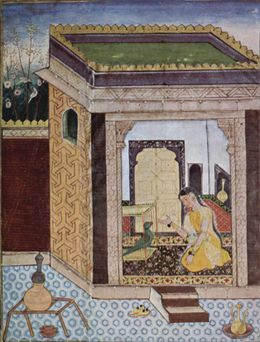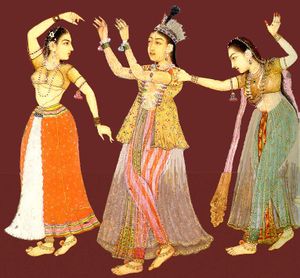توتينامه
توتينامه Tutinama، تعني حرفياً "حكايات الببغاء"، هي النسخة الفارسية من القرن الرابع عشر لسلسلة من 52 قصة، تضم 250 صورة منمنمة. النسخة المصورة صنعت بأمر من السلطان المغولي، أكبر في أواخر القرن السادس عشر. تاريخها الخلاق في القرن 14 الميلادي في إيران يرتبط أيضاً بروايات أقدم تسمى ‘الحكايات السبعون للببغاء’ بالسنسكريتية والتي جـُمِعت تحت عنوان شوكاساپتاتي Śukasaptati (جزء من أدب كتها katha) وتعود إلى القرن الثاني عشر الميلادي. ففي بلاد فارس، كما في الهند، تشتهر الببغاوات (في ضوء قدراتهم الحوارية المزعومة) كحكائين للقصص في الأعمال الروائية.[1][2][3][4][5]
قصص المغامرات التي يرويها الببغاء، في ليلة تلو الأخرى، على مدى 52 ليلة متعاقبة، هي قصص أخلاقية لإقناع صاحبته ألا ترتكب أي عمل فاحش مع أي حبيب ، في غياب زوجها. الصور تجمـِّـل الحكايات التي صـُنـِّفت في عهد أكبر، وتصور بوضوح الفكرة الرئيسية للحكاية عبر رسم منمنمات ذات أثر باقٍ. These were created in a span of five years after Akbar ascended the throne.[6][7]
تأليف النسخة المصورة من توتينامه تـُنسـَب إلى اثنين من الفنانين الفرس هما مير سيد علي وخواجة عبد الصمند من بلاط السلطان المغولي أكبر. وقد قاما برسم الصور المعبرة عن القصص الفارسية الأصل لتوتينامه بمنمنمات جميلة.[8]
تاريخ
تـُنسـَب حكايات توتينامه إلى ضياء الدين نخشبي، أو مجرد نخشبي، الطبيب الفارسي والناسك الصوفي الذي هاجر إلى بدايون، اوتار پرادش بالهند في القرن الرابع عشر، وكان يكتب باللغة الفارسية. وقد ترجم و/أو نقح نسخة تقليدية سنسكريتية من قصص تشبه توتينامه إلى الفارسية، حوالي 1335 م. ويـُستـَدل أن هذا الكتاب الصغير ذو القصص القصيرة، ذات الطابع الأخلاقي، ترك بالغ الأثر في نشأة أكبر. ويـُفهـَم كذلك أنه لما كان للسلطان أكبر حريم (من بناته وزوجاته وجواريه)، فإن القصص الأخلاقية كان لها اتجاه محدد وهو السيطرة على النساء.[2][5][7]
الفكرة الرئيسية للحكايات

الراوي الرئيسي للحكات الاثنين وخمسين في توتينامه هو ببغاء، يحكي تلك القصص لصاحبته، خوجاستا، لكي يمنعها من ارتكاب عمل فاحش في غياب زوجها (التاجر المدعو "ميموني") في التجارة. The merchant had gone on his business trip leaving behind his wife in the company of a myna and a parrot. The wife strangles the myna for advising her not to indulge in any illicit affair. The parrot, realising the gravity of the situation, adopts a more indirect approach of narrating fascinating stories over the next fifty-two nights. The stories are narrated every successive night for 52 nights as an entertaining episode to keep Khojasta's attention and distract her from going out.[1][10][11]
- احدى القصص
A particular tale narrated by the parrot to rivet the attention of his mistress, as she is about to leave the house in the night, is also depicted in the 35th to 37th paintings in the illustrated version of the Tutinama. The story related by the parrot is of a Brahmin boy falling in love with a princess, considered a fated (doomed) situation. But a solution to this is provided by a magician friend of the Brahmin in the form of magic beads to help his friend to turn into a beautiful woman to seek entry into the palace to be with his loved one. The magician further facilitates the meeting of his friend with the king’s daughter by telling the King that the girl in question was his daughter-in-law. On seeking entry into the palace the Brahmin discloses his true identity to his adored princess. But a twist is introduced into the tale with the King’s son beholding a beautiful girl (the Brahmin in disguise) while taking bath in a pond falls in love with her. To avoid discovery of his true identity, the Brahmin runs away with the King’s daughter. The magician then appears before the King seeking return of his daughter-in-law. But the King realising the true state of the two missing girls, compensates the magician with rich gifts. The gifts are passed on by the magician to his Brahmin friend and his wife to enable them to lead a happy life. The parrot concludes the narration, towards day break, with the advice to Kojasta that she should also have everything in life including her husband.[12]
أسلوب الرسوم
الهامش
- ^ أ ب Beach, Milo Cleveland (1992). Mughal and Rajput painting, Part 1, Volume 3. Cambridge University Press. pp. 21–38. ISBN 0521400279, 9780521400275. Retrieved 2009-09-23.
{{cite book}}:|work=ignored (help); Check|isbn=value: invalid character (help) خطأ استشهاد: وسم<ref>غير صالح؛ الاسم "Beach" معرف أكثر من مرة بمحتويات مختلفة. - ^ أ ب "Institute for Oriental Study, Thane: Seminar on "Suhbashita, Panchatantra & Gnomic Literature in Ancient & Medievel India"". Effect of this Migration on Art. Retrieved 2009-09-25.
- ^ Wilson, Horace Hayman (1836). Notes on the Indica of Ctesias. Ashmolean society,. pp. 52–53.
{{cite book}}:|work=ignored (help); Unknown parameter|accessdaste=ignored (help)CS1 maint: extra punctuation (link) - ^ A N D Haksar. "Shuka Saptati - Seventy Tales of the Parrot". Retrieved 2009-09-23.
- ^ أ ب "The Parrot". Retrieved 2009-09-21.
- ^ Beach p.34
- ^ أ ب Asher, Catherine Ella Blanshard (2006). India before Europe. Cambridge University Press. p. 313. ISBN 0521809045, 9780521809047. Retrieved 2009-09-23.
{{cite book}}:|work=ignored (help); Check|isbn=value: invalid character (help); Unknown parameter|coauthor=ignored (|author=suggested) (help) - ^ Beach p.28-29
- ^ [1]
- ^ Beach p.21
- ^ "Nasta'liq calligraphy as patronized by Akbar, c.1580". Retrieved 2009-09-25.[unreliable source?]
- ^ ”Beach” p.53
وصلات خارجية
| Mogul style
]].- CS1 errors: periodical ignored
- CS1 errors: ISBN
- CS1 errors: unsupported parameter
- Articles with unsourced statements from October 2009
- كتب بدون غلاف
- Articles using infobox templates with no data rows
- Pages using infobox book with unknown parameters
- No local image but image on Wikidata
- مدارس التصوير الهندي
- سلطنة المغل
- أدب فارسي
- مخطوطات مصورة
